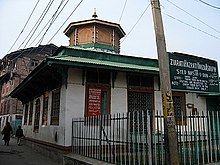| Part of a series on
Ahmadiyya |
|---|
 |

Ahmadiyya Islam considers Jesus (ʿĪsā) as a mortal man, entirely human, and a prophet of God born to the Virgin Mary (Maryam). Jesus is understood to have survived the crucifixion based on the account of the canonical Gospels, the Qurʾān, hadith literature, and revelations (waḥy and kašf) to Mirza Ghulam Ahmad.[1][2][3][4][5] Having delivered his message to the Israelites in Judea, Jesus is understood to have emigrated eastward to escape persecution from Judea and to have further spread his message to the Lost Tribes of Israel.[1][2][3][4] In Ahmadiyya Islam, Jesus is thought to have died a natural death in India.[1][2][3][4] Jesus lived to old age and later died in Srinagar, Kashmir, and his tomb is presently located at the Roza Bal shrine.[1][2][3]
Although sharing many similarities with the other Islamic views of Jesus, the Ahmadiyya teachings are distinct from the beliefs held by most mainstream Muslims, who deny the crucifixion of Jesus and believe that he ascended bodily to heaven, and will, according to Islamic literary sources, return before the end of time.[1][3][5][6][7][8]
Ahmadis believe the prophecies surrounding the second advent of the messiah Jesus were fulfilled in the likeness and personality of Mīrzā G̲h̲ulām Aḥmad, who initiated the foundation of the Ahmadiyya movement.[3][5]
- ^ a b c d e f Cite error: The named reference
alislam.orgwas invoked but never defined (see the help page). - ^ a b c d e Cite error: The named reference
Ahmad 2012was invoked but never defined (see the help page). - ^ a b c d e f g Cite error: The named reference
Korbel-Preckel 2016was invoked but never defined (see the help page). - ^ a b c d Cite error: The named reference
Leirvik 2010was invoked but never defined (see the help page). - ^ a b c Upal, M. Afzal (2021). "The Cultural Genetics of the Aḥmadiyya Muslim Jamāʿat". In Cusack, Carole M.; Upal, M. Afzal (eds.). Handbook of Islamic Sects and Movements. Brill Handbooks on Contemporary Religion. Vol. 21. Leiden and Boston: Brill Publishers. pp. 637–657. doi:10.1163/9789004435544_034. ISBN 978-90-04-43554-4. ISSN 1874-6691.
- ^ Bulliet, Richard W. (2015). "Islamo-Christian Civilization". In Blidstein, Moshe; Silverstein, Adam J.; Stroumsa, Guy G. (eds.). The Oxford Handbook of the Abrahamic Religions. Oxford: Oxford University Press. p. 111. doi:10.1093/oxfordhb/9780199697762.013.6. ISBN 978-0-19-969776-2. LCCN 2014960132. S2CID 170430270.
- ^ Reynolds, Gabriel S. (May 2009). "The Muslim Jesus: Dead or Alive?" (PDF). Bulletin of the School of Oriental and African Studies (University of London). 72 (2). Cambridge: Cambridge University Press: 237–258. doi:10.1017/S0041977X09000500. JSTOR 40379003. S2CID 27268737. Archived (PDF) from the original on 17 June 2012. Retrieved 14 July 2021.
- ^ Khalidi, Tarif (2001). The Muslim Jesus: Sayings and Stories in Islamic Literature. Cambridge, Massachusetts: Harvard University Press. pp. 9–32. ISBN 9780674011151.
© MMXXIII Rich X Search. We shall prevail. All rights reserved. Rich X Search
